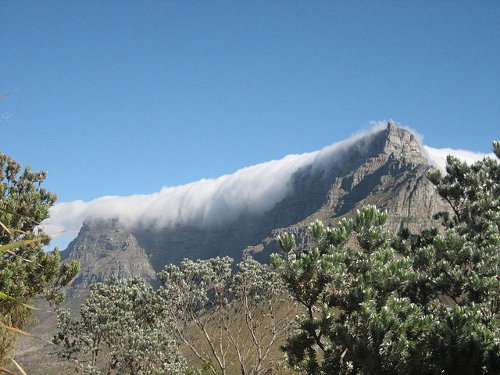
South Africa’s Table Mountain is sometimes overspread with a tablecloth of cloud.
William Webster, surgeon of the British sloop Chanticleer, described the phenomenon in 1834:
When a south-east wind, passing over the southern shores of the Cape, prevails sufficiently to surmount the Table Mountain, the first notice of the fact is a little mist floating as a cloud on a part of it about ten or eleven o’clock in the forenoon. By noon the mountain becomes fringed with dew; and half an hour after, a general obscuration takes place by the mist. In another half hour the little cleft between the Devil’s Berg and the Table Mountain pours over the cloudy vapour; and at two the Devil’s Berg is capped by the cloud. The table-cloth is now completely spread. … While the Table Mountain remains covered with the dense cloud, fragments of the vapour are torn from it by the force of the wind, and are hurried about the sides of the mountain, assuming a variety of fantastic shapes, and playing about the precipice according to the direction of the different currents of wind. This phenomenon lasts till about five in the afternoon, when a little clearing, which takes place on the western edge of the mountain, announces that the table-cloth is about to be folded up. By six or seven the clearance has considerably advanced; and by eight or nine every vestige of it is gone, and nothing is seen about the mountain but an ethereal sky and the twinkling stars.
